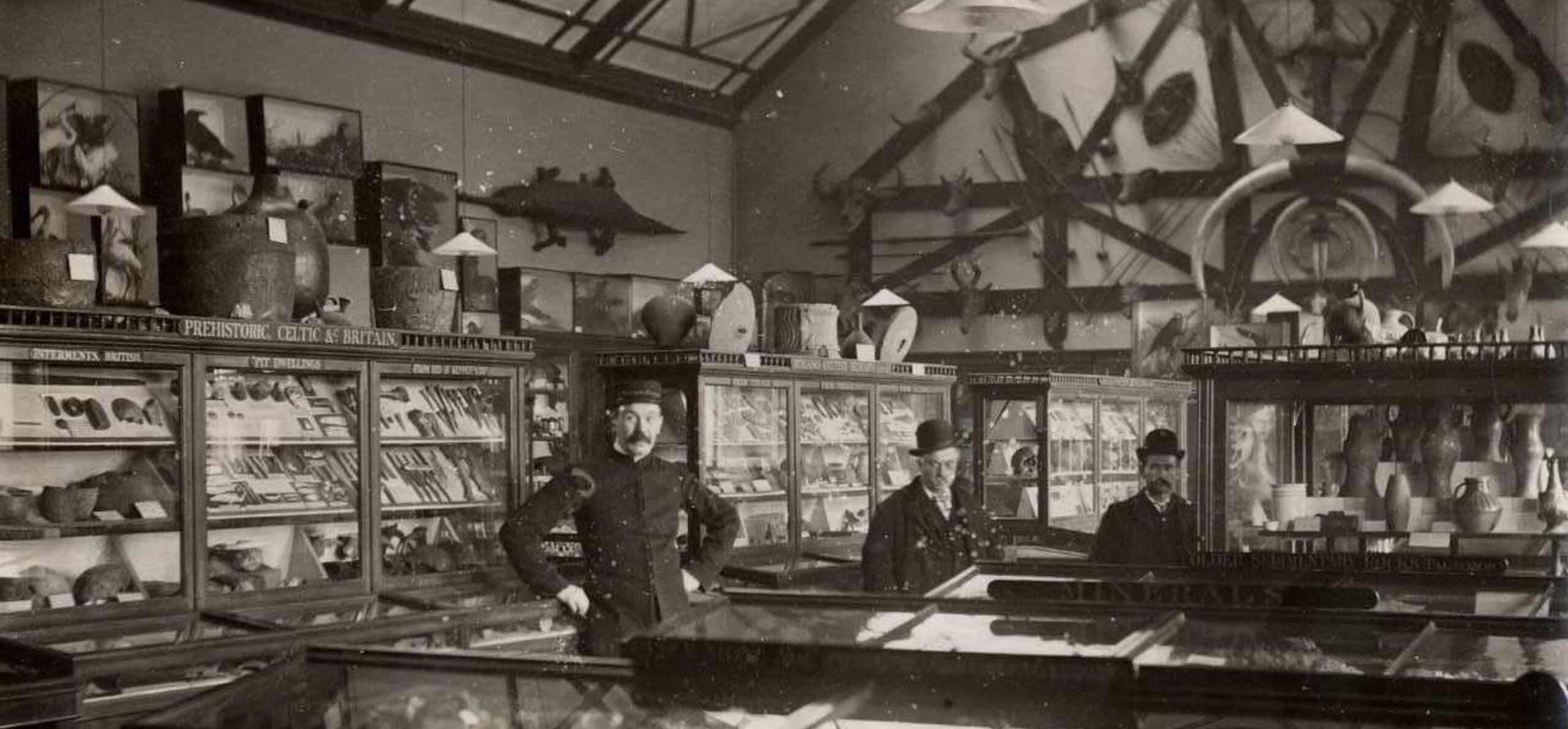Reading Museum’s founding collection was offered to Reading Corporation in 1877 by the trustees of the late Horatio Bland (1802-1876). At his country estate at Burghfield, six miles south of Reading, Mr Bland had created his own private museum collection. During extensive travels, he had collected artefacts ranging from a duck-billed platypus to Egyptian papyrus. But who was he?
Read on to learn about the man behind our founding collection and how his collection ended up in Reading.
Beginnings in Newfoundland
Horatio was born in about 1802 at Trinity Bay, Newfoundland, Canada (1). His parents were John (1760-1826) and Sarah Bland (1762-1836). John was born in Devon and had arrived in Newfoundland and married Sarah by 1789. He was probably a merchant’s agent, first becoming a magistrate and in 1809 he was appointed High Sheriff of Newfoundland. John was a forthright, decisive and confident individual, who established himself as a man of integrity and honesty in official circles. He took a special interest in the welfare of the dwindling indigenous people, the Beothuk, particularly condemning fisherman and furriers for their treatment and alienation of the Beothuks (2).
An adventurous family
John and Sarah had eight children, including Horatio, who used their family’s mercantile contacts to seek their fortunes across the globe.
Horatio’s oldest sister Arabella (c. 1790-1823) married James Pointer Garland (1789-1830) in 1817. James Garland was the fishery agent in Trinity Bay for his uncle George Garland (of Poole, England), the owner of the Lester-Garland Merchant Company that traded in Newfoundland fish (cod in particular). By 1823, Arabella and James had moved to Lisbon, Portugal, probably to work in the brokerage house that his uncle established there in 1812. (3) Horatio's second sister Elizabeth (1792-1855) married another trader Robert Hutton who was based in Liverpool. John Bayley Bland (1794-1871), the oldest brother, stayed in Newfoundland, but he was also a businessman. He trades with the West Indies, Madeira, Gibraltar and Quebec. The second oldest brother, Marcus Hill Bland (1796-1856) set up the Middleton Bland trading and shipping company in Gibraltar.
Chilean business
Horatio seems to have left Newfoundland in about 1823, following in the footsteps of his siblings looking for his future in the world of international trade. He spent time in New York and Liverpool before travelling to South America, where he went into business with William Joseph Myers, a Liverpool merchant. Together, Horatio and Myers set up a merchant house at the port of Valparaiso in Chile, trading as Myers, Bland and Company. Chile had gained independence from Spain in 1818 and international trading opportunities were expanding rapidly, and there was a large British community in Valparaiso.
Horatio obviously knew the saying ‘where there’s muck, there’s brass’, because in the 1830s he was speculating on a new agricultural fertiliser: guano, the accumulated droppings of sea birds over many centuries. The name is derived from the Peruvian word huano, meaning dung. Several Peruvian islands had rich guano deposits, and Peruvian merchant, Francisco Quiroz, was at the forefront of efforts to promote a guano trade. It was William Myers who first provided Quiroz with some capital and agreed to handle guano consignments in England.
It was through the Myers, Bland and Company that thirty bags of guano arrived in Liverpool from Valparaiso on board the ship Heroine in July 1839, consigned to the parent house, W.J. Myers and Company. (4) The month before, on 11 June, Bland’s partnership in Valparaiso with Myers and another merchant James Whiteread was dissolved, seemingly to set up the Myers-Bland Company, in association with Quiroz. It was the first company to send guano to Britain commercially. The first load was in 1841 under an exclusive contract with the Peruvian government. (5) (17) The company seems not to have renewed these contracts after 1848 but continued trading in Chile until the 1860s (17).
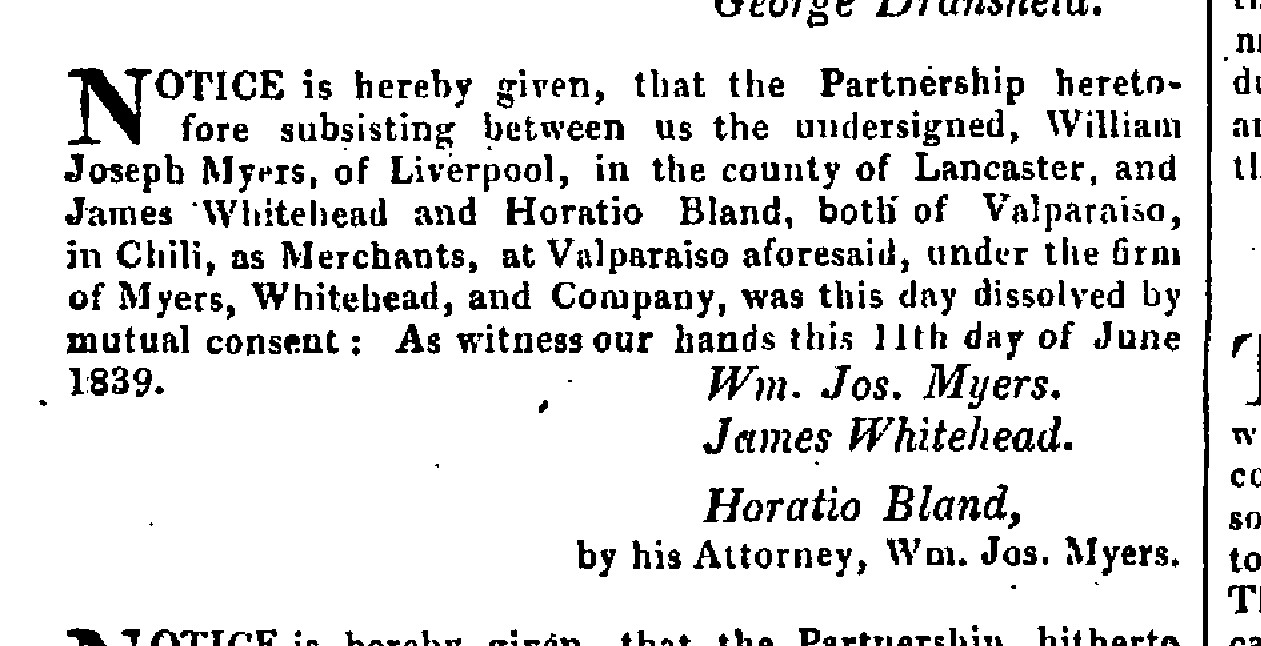
This notice in the London Gazette, 1840, states the end of Horatio Bland's partnership with Myers and Whitehead in Chile.
Horatio's favourite nephew
In 1846, Horatio’s nephew Thomas Bland Garland (1819-1892) arrived in Valparaiso, and worked with his uncle until 1853 exporting guano, copper, and other goods. Thomas remained close to his uncle Horatio for the rest of his life, but it was not long before Thomas was investing in his own enterprises. These included the distillation of freshwater from seawater on the Bolivian coast, setting up the Bank of Valparaiso in 1856 and supervising the opening of a new railway line in 1861 to new mining districts in Chile’s interior. Thomas finally returned to England in 1872 at his uncle’s request. (6 and 7)
The move to England and marriage
By the 1840s, Horatio had moved to England, where in 1847 he married Emily Alicia Cherry (1826 – 1868), the oldest daughter of the Rector of Burghfield, Rev Henry Curtis Cherry (1798-1864), and Anne Alicia Cameron (1805-1852). Henry Cherry’s father had acted as Governor of Bombay and Henry’s brother was a member of the Madras Civil Service.
Horatio and Emily’s first home was a large Georgian house called Culverlands at Burghfield Hill. He also owned adjoining land at Burghfield Common and in 1855 he bought Hartley Grange at Hartley Witney, Hampshire (8).
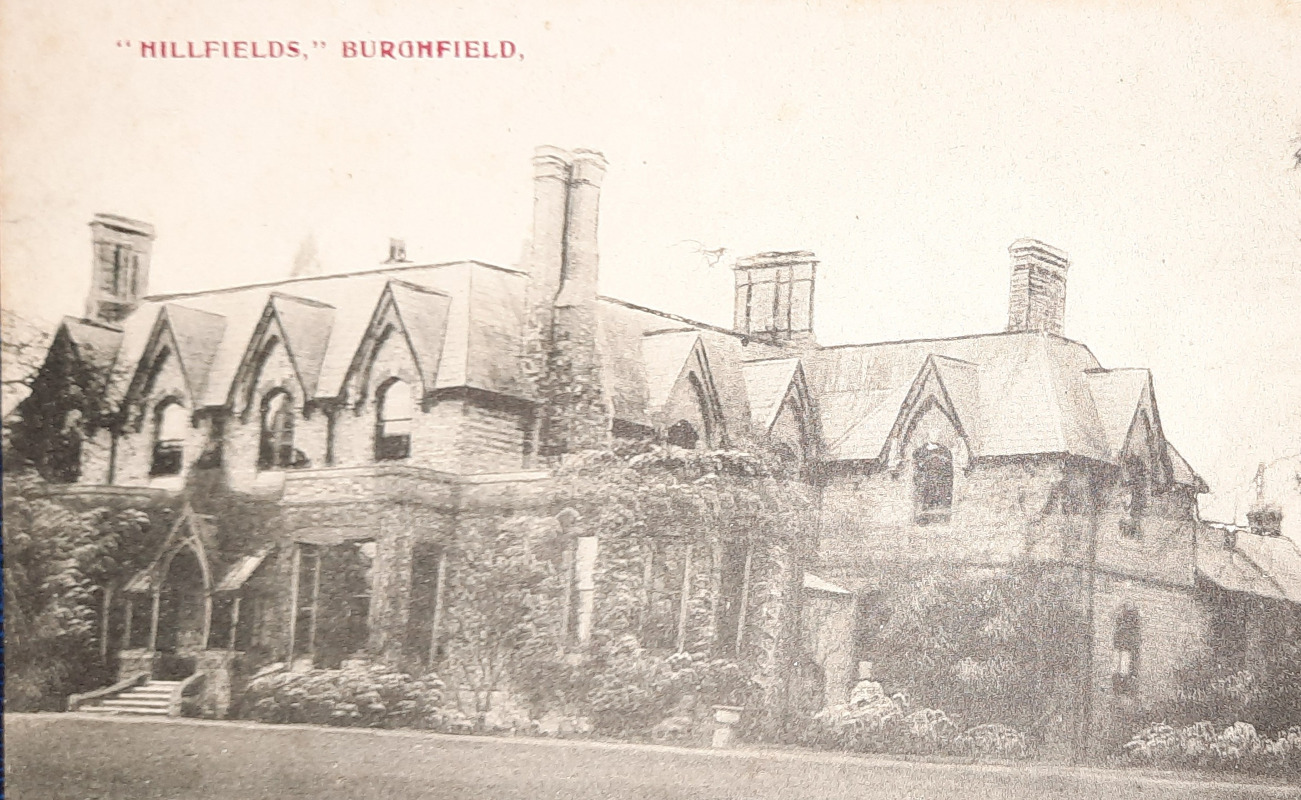
Postcard of Hillfields house, Burghfield, built in 1861-2 for Horatio Bland.
A new home (and museum) in Burghfield
In 1861, Horatio commissioned Liverpool architect Walter Scott (1815-1884) to design a new red and blue brick gabled house with a slate roof on his land at Burghfield Common. Scott’s wife, Sarah Hutton Scott, was in fact Horatio’s niece.
This new home, named Hillfields, was constructed at a cost of £2,961 in 1861-1862. Today, it is the headquarters of Guide Dogs for the Blind. (9) Horatio must have been collecting for many years before he created his first purpose-built museum building at Hillfields in 1861-62. An 1892 sales catalogue for Hillfields describes a ‘detached Brick and Slated Building erected for a Museum, but now available for a Billiard Room, 25ft. by 20ft. and a Smoking Room, 20ft. by 14ft., with a Room over, 40ft. by 20ft. and dry Basement Storerooms, Cellarage, and a fireproof Room fitted with Milner’s fireproof door'. (14)
Family scandal
Rev Henry Cherry (Horatio's father-in-law) was the rector of Burghfield for 37 years until his death in 1864. He and his first wife Anne had eight daughters and seven sons before Anne died in 1852. In August 1853, Rev Cherry married Emily Sutherland, the widow of Colonel Sutherland (Cherry’s brother-in-law’s brother). This marriage did not go well, and according to Emily’s own account ‘from the first moment of her marriage she was a miserable woman’ (10).
There were major disagreements between Emily Cherry and her mother-in-law over the upbringing of Emily's youngest stepchild, and Henry took his mother's side. Eventually, in 1855, Emily took the scandalous step of leaving Henry. He tried to bring her back, at least once by force in 1856, and in 1857 she applied to the court of Queen's bench to protect her. The case went against Henry and he was ordered to pay sureties amounting to £200. These proceedings can have done nothing for Henry's reputation. Henry died at Burghfield in 1864 aged 66. (11)
Horatio and Emily Bland’s minor role in this scandal was recorded in newspaper accounts of the court case. They had visited the Rev Henry Cherry the day after he had forcibly brought his estranged wife Emily Cherry back to Burghfield from her lodgings in Reading. According to Emily Cherry, ‘I was rescued by Mrs Bland’, who took her to her home at Hartley Grange (10).
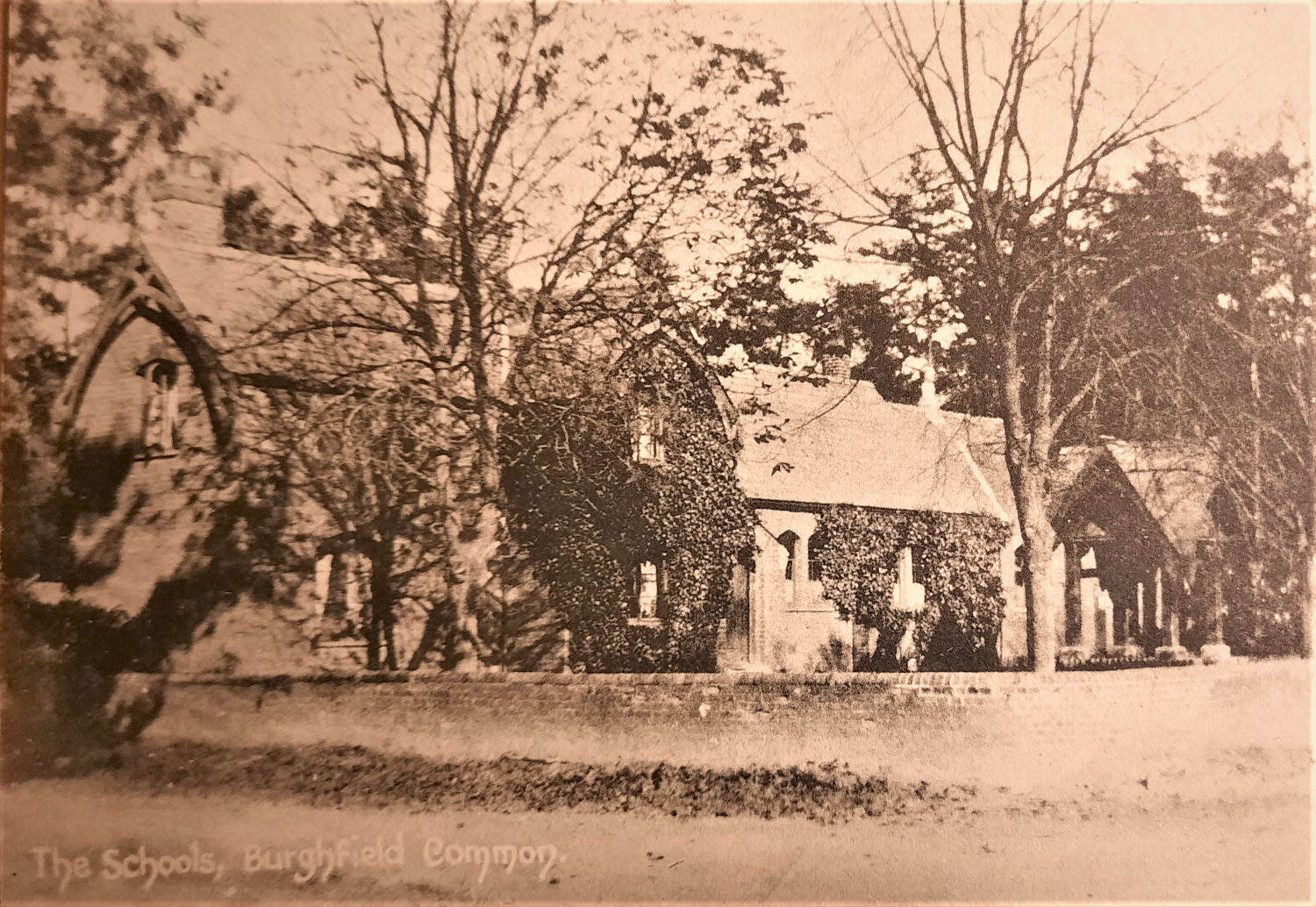
Mrs Bland's School, Burghfield Common in about 1900.
Later-life travels and the founding of Mrs Blands School
Horatio supported the Palestine Exploration Fund, and it was on an expedition to the Holy Land in March 1868 that his wife Emily died. She was buried in Jerusalem’s Protestant Cemetery. (17)
By August 1868, Horatio had travelled to St John's, Newfoundland. A Newfoundlander newspaper reported his donation of £5 to the Orphans Fund and recorded that he was 'a native of this country, made a visit here, after an absence of 46 years'. (12) In 1872, he visited Tasmania as governor of the Van Diemen's Land Company, a capacity in which he served from 1869 to 1873. (17)
Horatio founded Mrs Bland’s School at Burghfield Common in memory of his wife by deed on 6 January 1872. The school bell was a large Japanese temple bell dating to 1746 that Horatio had collected on his travels. In 1953, it was given to the Ashmolean Museum, Oxford [Ashmolean EAX.3888]. (13)
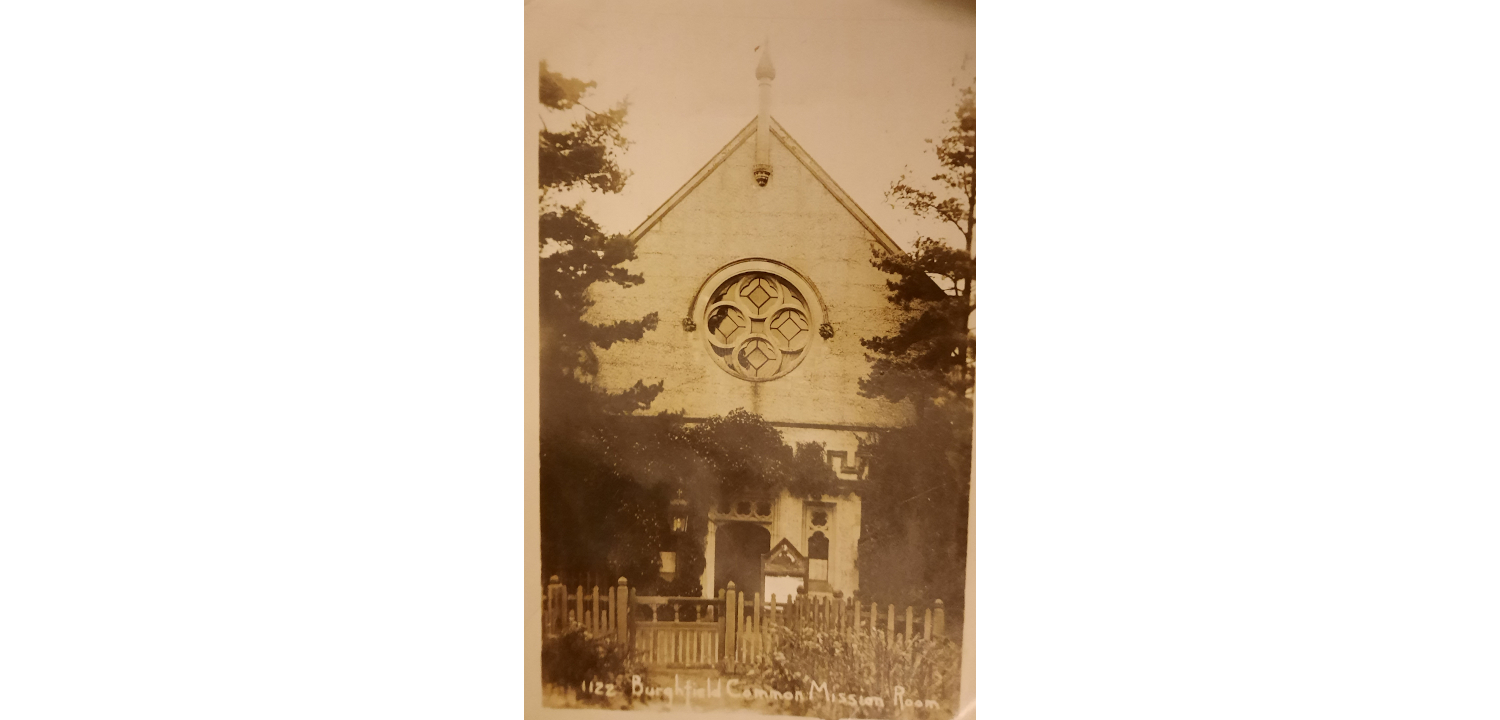
The Burghfield Common Parish Room was originally built as the Bland Collection Museum.
The Bland Collection and Reading Museum
In 1874, Horatio built a new museum adjacent to the school for his growing museum collection, replacing the smaller museum building at Hillfields. This new building contained one large gallery, which was sixty by twenty-five feet.
The arrangement of Bland’s eclectic collection inside this building was recorded by in 1882 by Dr Joseph Stevens, the first curator of Reading Museum. Ten cases stood in two parallel rows in the centre of the gallery surrounded by wall-mounted cases and objects. A ‘fine African lion’ was mounted at the end of the rows of cases. The ten cases contained Bland’s extensive collection of marine shells, particularly from Australia, Papua and the Philippines, but had ‘neither arrangement, classification nor identification’. On the wall facing the door was a collection of African animal heads, from hippo to antelope, intermingled weapons and implements from Africa and the Pacific. The end wall cases contained Egyptian, Greek and Peruvian pottery, and a mummy head. Another wall case contained Australian animals including kangaroos and duck-billed platypus. (15) (18)
Horatio died on 31 March 1876 and was buried at St Mary’s churchyard, Burghfield. His will left a life interest of Hillfields to his nephew Thomas Bland Garland, as well as smaller legacies to other relations. The residue of his around £50,000 estate went to his son, Captain Horatio Bland Guerre, who was born in Valparaiso in 1838.
Thomas Garland offered the Bland Collection to Reading Corporation in 1877 and was one of the subscribers giving funds to build and furnish the new museum galleries at Reading Town Hall. After the collection was permanently transferred to Reading Museum in September 1882, the former museum room was refitted by his trustees as a parish or mission room that opened in 1886. The original Mrs Bland’s School and Parish Room were demolished in the 1960s. In 1972, they were replaced by Bland’s Court sheltered accommodation in 1972. (16)
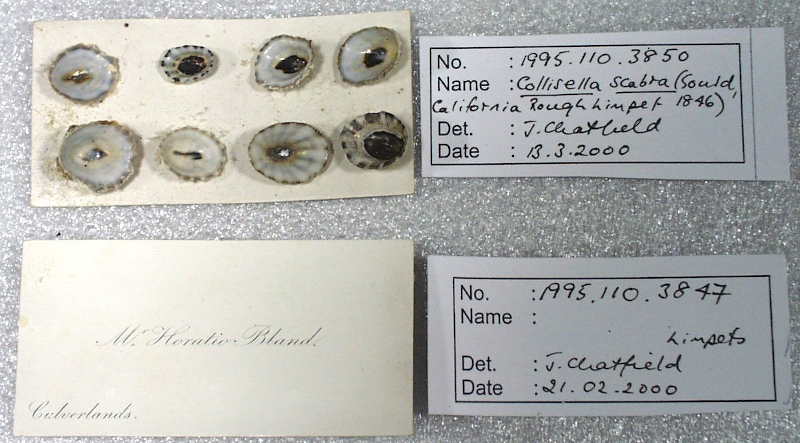
Horatio Bland used his own visiting card to mount these limpet shells that are now part of Reading Museum's shell collection (museum no. 1995.110)
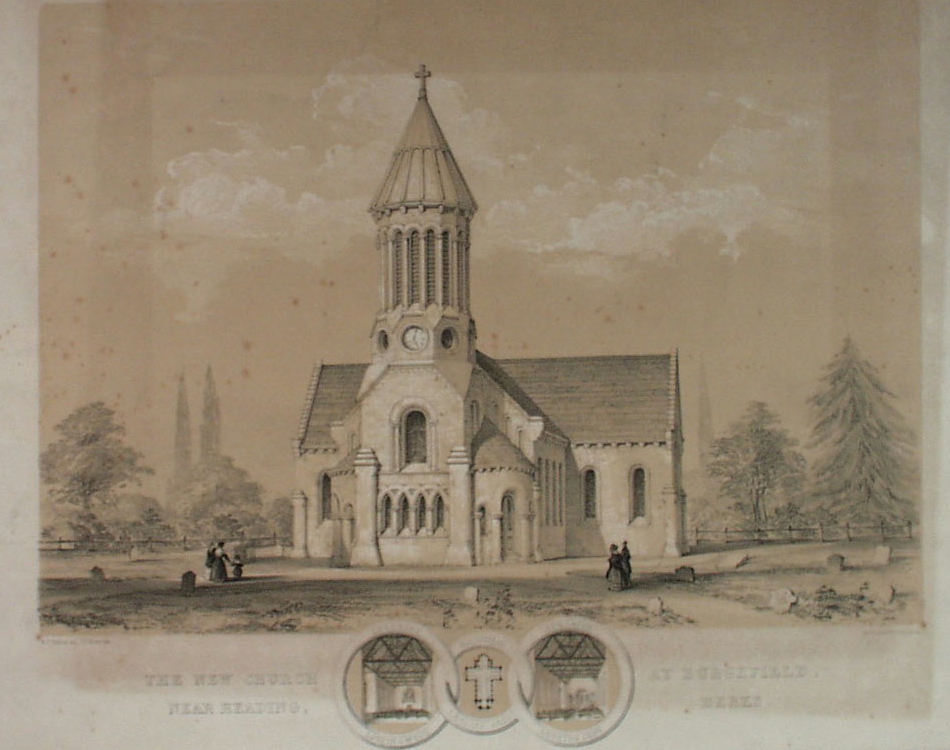
The New Church at Burghfield, near Reading, Berks', by W F Poulton, 1843 (museum no. 1983.275.1)
References
(1) Horatio Bland was baptised aged 2 on 30 January 1804 at Trinity Bay, Newfoundland, along with his siblings John Bailey (aged 10), Marcus Hill (aged 8), Fanny (aged 4).
(2) W. Gordon Handcock, “BLAND, JOHN,” in Dictionary of Canadian Biography, vol. 6, University of Toronto/Université Laval, 2003–, accessed February 26, 2021, http://www.biographi.ca/en/bio/bland_john_1825_6E.html
(3) W. Gordon Handcock, “GARLAND, GEORGE,” in Dictionary of Canadian Biography, vol. 6, University of Toronto/Université Laval, 2003–, accessed February 26, 2021, http://www.biographi.ca/en/bio/garland_george_6E.html
(4) “The African Guano Trade”. (2003). In R. Craig (Ed.), British Tramp Shipping, 1750–1914 (pp. 85-120). Liverpool University Press.
(5) London Gazette 29 May 1840
(6) Reading Mercury - Saturday 29 October 1892
(7) Thomas Bland Garland (1819- 1892) Obituary in Minutes of the Proceedings of the Institution of Civil Engineers, Volume 109, 1892, pp. 426-428 - www.icevirtuallibrary.com/doi/abs/10.1680/imotp.1892.20377
(8) Post Office Directory for Hampshire, Wiltshire and Dorsetshire 1855
(9) https://manchestervictorianarchitects.org.uk/buildings/hillfields-hermi…
(10) Reading Mercury, Saturday 18 December 1858
(11) https://collections.reading.ac.uk/special-collections/collections/cherr…
(12) The Newfoundlander, Feb 1869 re an August 1868 event
(13) https://collections.ashmolean.org/object/402531
(14) Berkshire Record Office (D/EX1940)
(15) Reading Observer - Saturday 03 June 1882
(16) Entry on Heritage Gateway website https://heritagegateway.org.uk/Gateway/Results_Single.aspx?uid=MWB19624…
(17) "Bland, Horatio (1802?–1876), merchant and collector". Oxford Dictionary of National Biography https://www.oxforddnb.com/view/10.1093/ref:odnb/9780198614128.001.0001/…
(18) A descriptive catalogue of the Reading Museum. Part 1, Ethnological collection / by Joseph Stevens, 1896. https://wellcomecollection.org/works/prgu4edk
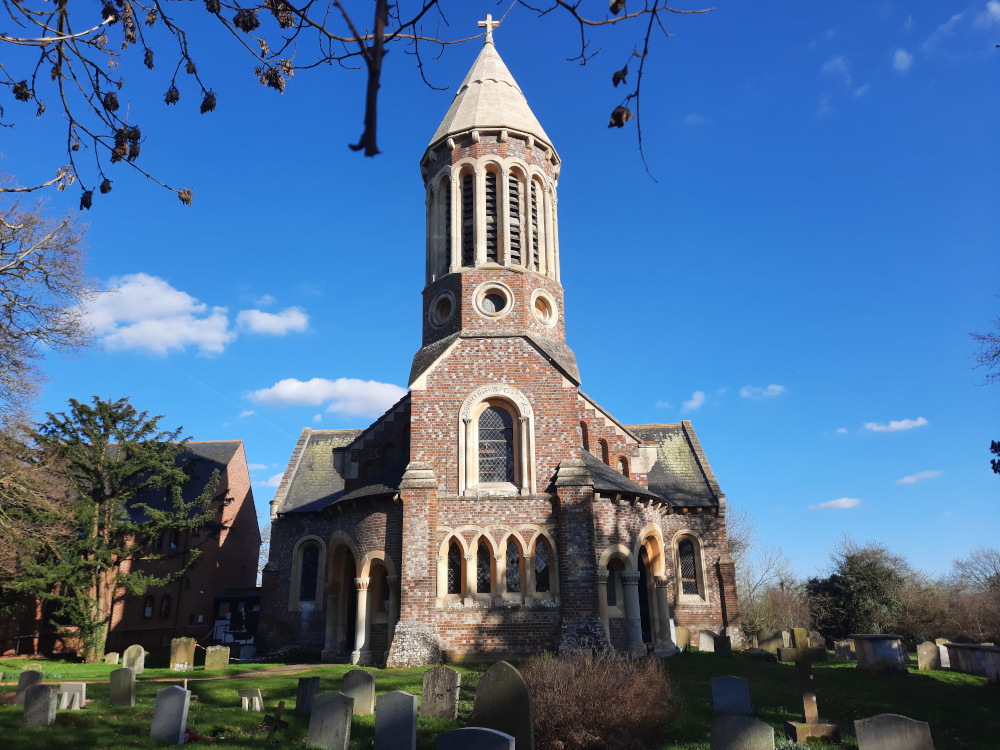
Burghfield Parish Church. Horatio is buried in the churchyard.
